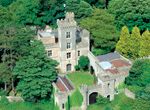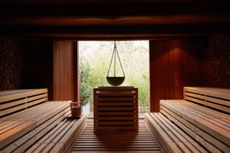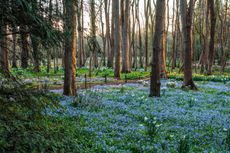Castles for sale
There are at least two stunning castles on the market, perfect for buyers with a romantic imagination


Set high on a rocky outcrop 600ft above sea level, and surrounded by the 300-acre National Trust enclave of Rodborough Common, historic Rodborough Fort at Minchinhampton, Gloucestershire, overlooks an ancient highway that once linked London with Severn cross-ings at Upper Framilode and Arlingham, and later became the main route linking the capital with the cloth-producing town of Stroud. The Romans built the first fort on Rodborough Hill to protect their encamp-ment at Woodchester in the valley below; today, the fort guards the remains of Woodchester's Roman governor's villa, one of the largest ever unearthed in England. The present fort dates from the 1760s, when a garrison of 250 men and 32 cannon kept law and order in the countryside, protecting travellers from highwaymen such as the notorious Tom Long, who was hanged on Rodborough Common. In the 1800s, the converted fort was home to a succession of prominent Stroud businessmen, among them Alexander Halcombe, who rebuilt it in 1870 as a two-storey house with a tower. Racing driver and aviator extraordinaire Robert Lamplough grew up in Woodchester, in the shadow of Rod-borough Fort. Twelve years ago, his family trust bought the dilapidated fort from the National Trust and set about restoring it. The renovation was master-minded by Mr Lamplough's brother Peter, who had intended to make it his home, but decided instead to settle in Africa: hence its sale, through Savills (01285 627550), at a guide price of £1.85 million. With 5,060sq ft of living space not including cellars and outbuildings Rod-borough Fort, listed Grade II, can accommodate not only an extended family, but a regular army of guests. It has four grand reception rooms set around a wide Baroque hall with a fine oak staircase, a large kitchen/breakfast room, seven bedrooms and five bathrooms. The rooftop terrace and most of the principal rooms share spectacular views of the Malvern Hills and Black Mountains to the west. Within the 8.84 acres of grounds, an expanse of parkland once used for grazing soldiers' horses now serves as the owner's helipad. Yet for all its lofty eminence, Rodborough Fort enjoys total seclusion, thanks to the high Cotswold-stone boundary wall which completely encloses the property. The setting for Scotland's Easterheughs Castle, halfway between the villages of Aberdour and Burntisland on the rugged Fife coast, is no less romantic, yet few would guess that this perfect example of a traditional 16th-century laird's house was built less than 60 years ago. Easterheughs was the brainchild of scientist William Thomas, who was manager of the British Aluminium Company's laboratory at Burntisland when war was declared in 1945. He joined the Home Guard, and while on coastal fire-watch duty, spotted the outcrop of rock on which he determined to build his dream castle once the war was over. In 1946, he duly bought the site and commissioned Kirkcaldy architects Williamson and Hubbard to draw up plans based on the design of nearby medieval Rossend Castle. Over the next 15 years, Thomas turned his dream into reality, salvaging stone from the villages of High and Low Binns, when they became a spoiling ground for the aluminium works, reclaiming window stones from Otterston Castle, crow-step and step-gabling from other historic buildings, and curved roof tiles from Auchterpool distillery. Roof timbers were made from railway sleepers and minesweeper keels, and much of the interior was finished with panelling and fireplaces bought from the then derelict Rossend Castle at £6 a load. Easterheughs ('the eastern cliff overhanging the river') faces south, with dramatic views across the Firth of Forth to Edinburgh. Its lawn and much of the garden lie 100ft below the house, the steep drop forming a natural rock garden where Thomas planted many unusual plants. On his death in 1989, the castle was put up for sale and eventually bought by Scottish artist Jack Vettriano, who added a studio and garages in the same style. Most of the work for his New York exhibition 'Lovers and Other Strangers' was completed here. In 2002, Mr Vettriano decided to move on, and Easterheughs was bought by former Arsenal footballer Jimmy Carter, who moved there from Hertfordshire with his extended family. Now happily settled in Perthshire, Mr Carter has had the castle renovated to 21st-century standards, repainting Mr Vettriano's Gothic-red interiors and converting the former studio to a one-bedroom coach house. Savills (0131?247 3700) are seeking offers over £1.65m for Easter-heughs, recently listed Grade A, which has three main reception rooms, five bedrooms, two bathrooms, a home cinema, and two acres of woodland gardens and grounds.
Sign up for the Country Life Newsletter
Exquisite houses, the beauty of Nature, and how to get the most from your life, straight to your inbox.
Country Life is unlike any other magazine: the only glossy weekly on the newsstand and the only magazine that has been guest-edited by HRH The King not once, but twice. It is a celebration of modern rural life and all its diverse joys and pleasures — that was first published in Queen Victoria's Diamond Jubilee year. Our eclectic mixture of witty and informative content — from the most up-to-date property news and commentary and a coveted glimpse inside some of the UK's best houses and gardens, to gardening, the arts and interior design, written by experts in their field — still cannot be found in print or online, anywhere else.
-
 How to disconnect from reality and feel like a new person in under 72 hours
How to disconnect from reality and feel like a new person in under 72 hoursOur round-up of the best British retreats that work wellness wonders in under 72 hours.
By Jennifer George Published
-
 Evenley Wood Garden: 'I didn't know a daffodil from a daisy! But being middle-aged, ignorant and obstinate, I persisted'
Evenley Wood Garden: 'I didn't know a daffodil from a daisy! But being middle-aged, ignorant and obstinate, I persisted'When Nicola Taylor took on her plantsman father’s flower-filled woodland, she knew more about horses than trees, but, as Tiffany Daneff discovers, that hasn’t stopped her from making a great success of the garden. Photographs by Clive Nichols.
By Tiffany Daneff Published

